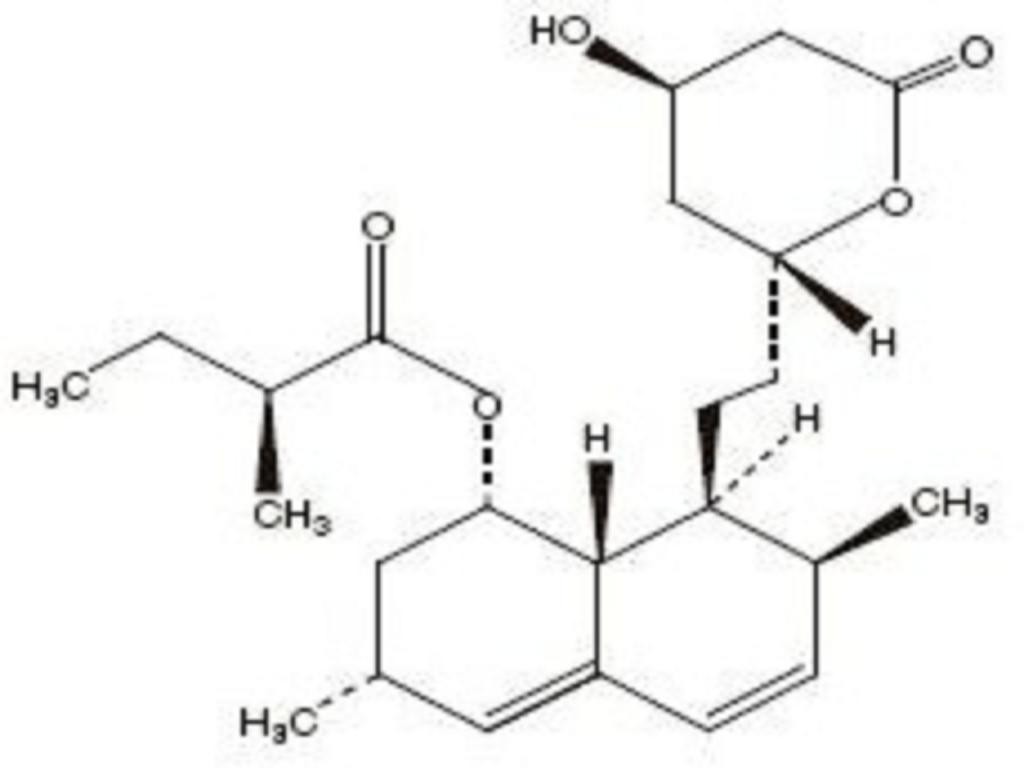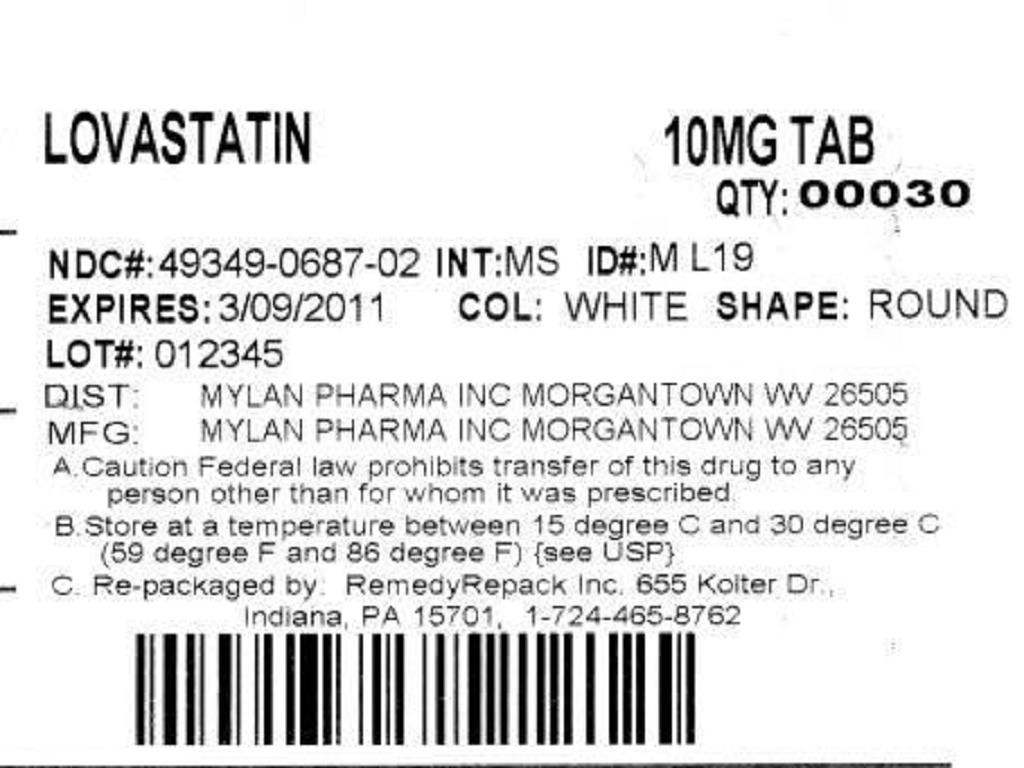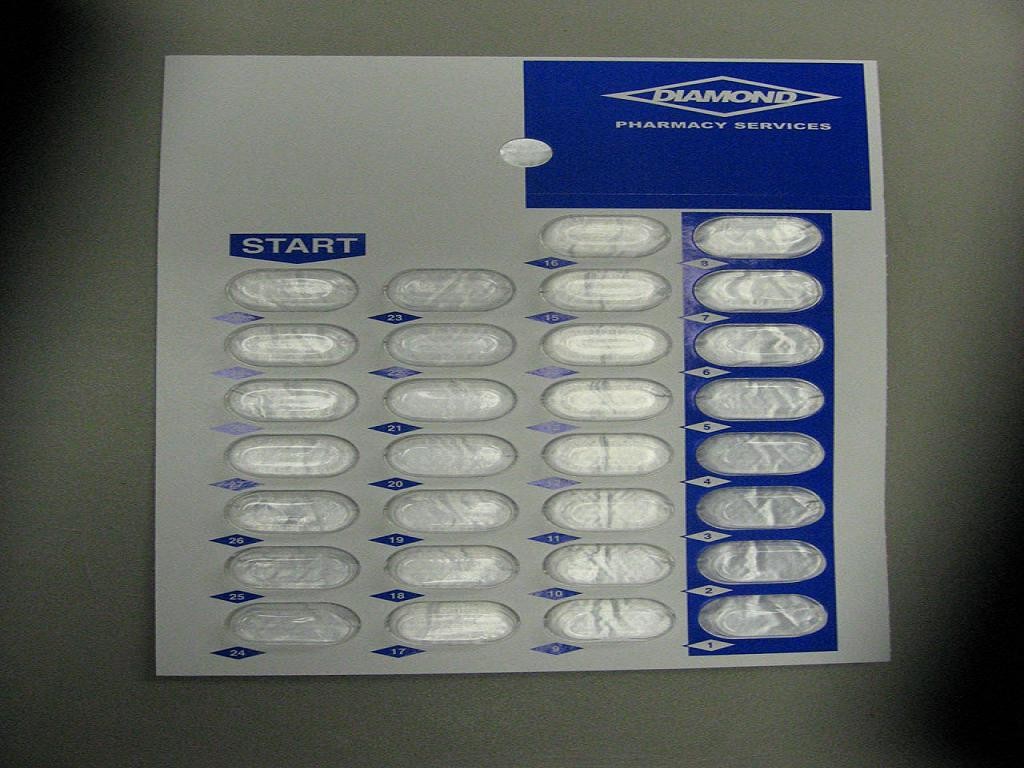Lovastatin
FULL PRESCRIBING INFORMATION: CONTENTS*
- LOVASTATIN DESCRIPTION
- CLINICAL PHARMACOLOGY
- PHARMACOKINETICS
- CLINICAL STUDIES
- INDICATIONS & USAGE
- LOVASTATIN CONTRAINDICATIONS
- WARNINGS
- PRECAUTIONS
- INFORMATION FOR PATIENTS
- DRUG INTERACTIONS
- CARCINOGENESIS & MUTAGENESIS & IMPAIRMENT OF FERTILITY
- PREGNANCY
- NURSING MOTHERS
- PEDIATRIC USE
- GERIATRIC USE
- LOVASTATIN ADVERSE REACTIONS
- OVERDOSAGE
- DOSAGE & ADMINISTRATION
- HOW SUPPLIED
- INACTIVE INGREDIENT
- PACKAGE LABEL.PRINCIPAL DISPLAY PANEL SECTION
FULL PRESCRIBING INFORMATION
LOVASTATIN DESCRIPTION

CLINICAL PHARMACOLOGY
Tables I through III under Clinical Studies
PHARMACOKINETICS
PRECAUTIONS: Geriatric Use
WARNINGS: Myopathy/RhabdomyolysisPRECAUTIONS: Drug Interactions
PRECAUTIONS: Drug Interactions11
1402.
CLINICAL STUDIES
Clinical Studies in AdultsTables I through III
DOSAGENTOTAL-CLDL-CHDL-CLDL-C/TOTAL-C/TGHDL-CHDL-CTable II
TREATMENTLDL-C/TOTAL-C/NTOTAL-CLDL-CHDL-CHDL-CHDL-CVLDL-CTG.(mean)(mean)(mean)(mean)(mean)(median)(mean)LovastatinCholestyramine
Expanded Clinical Evaluation of Lovastatin (EXCEL) Study
Table III
DOSAGELDL-C/TOTAL-C/N*TOTAL-CLDL-CHDL-CHDL-CHDL-CTG.(mean)(mean)(mean)(mean)(mean)(median)*PlaceboLovastatin
Air Force/Texas Coronary Atherosclerosis Prevention Study (AFCAPS/TexCAPS)
Figure 12 risk factors had risk reductions (RR) in both acute major coronary events (RR 43%) and coronary revascularization procedures (RR 37%). Because there were too few events among those participants with age as their only risk factor in this study, the effect of lovastatin on outcomes could not be adequately assessed in this subgroup.

Atherosclerosis
In the Canadian Coronary Atherosclerosis Intervention Trial (CCAIT), the effect of therapy with lovastatin on coronary atherosclerosis was assessed by coronary angiography in hyperlipidemic patients. In the randomized, double-blind, controlled clinical trial, patients were treated with conventional measures (usually diet and 325 mg of aspirin every other day) and either lovastatin 20 mg to 80 mg daily or placebo. Angiograms were evaluated at baseline and at 2 years by computerized quantitative coronary angiography (QCA). Lovastatin significantly slowed the progression of lesions as measured by the mean change per patient in minimum lumen diameter (the primary endpoint) and percent diameter stenosis, and decreased the proportions of patients categorized with disease progression (33% vs. 50%) and with new lesions (16% vs. 32%).
In a similarly designed trial, the Monitored Atherosclerosis Regression Study (MARS), patients were treated with diet and either lovastatin 80 mg daily or placebo. No statistically significant difference between lovastatin and placebo was seen for the primary endpoint (mean change per patient in percent diameter stenosis of all lesions), or for most secondary QCA endpoints. Visual assessment by angiographers who formed a consensus opinion of overall angiographic change (Global Change Score) was also a secondary endpoint. By this endpoint, significant slowing of disease was seen, with regression in 23% of patients treated with lovastatin compared to 11% of placebo patients.
In the Familial Atherosclerosis Treatment Study (FATS), either lovastatin or niacin in combination with a bile acid sequestrant for 2.5 years in hyperlipidemic subjects significantly reduced the frequency of progression and increased the frequency of regression of coronary atherosclerotic lesions by QCA compared to diet and, in some cases, low dose resin.
The effect of lovastatin on the progression of atherosclerosis in the coronary arteries has been corroborated by similar findings in another vasculature. In the Asymptomatic Carotid Artery Progression Study (ACAPS), the effect of therapy with lovastatin on carotid atherosclerosis was assessed by B-mode ultrasonography in hyperlipidemic patients with early carotid lesions and without known coronary heart disease at baseline. In this double-blind, controlled clinical trial, 919 patients were randomized in a 22 factorial design to placebo, lovastatin 10 mg to 40 mg daily and/or warfarin. Ultrasonograms of the carotid walls were used to determine the change per patient from baseline to 3 years in mean maximum intimal-medial thickness (IMT) of 12 measured segments. There was a significant regression of carotid lesions in patients receiving lovastatin alone compared to those receiving placebo alone (p = 0.001). The predictive value of changes in IMT for stroke has not yet been established. In the lovastatin group there was a significant reduction in the number of patients with major cardiovascular events relative to the placebo group (5 vs. 14) and a significant reduction in all cause mortality (1 vs. 8).
Eye
There was a high prevalence of baseline lenticular opacities in the patient population included in the early clinical trials with lovastatin. During these trials the appearance of new opacities was noted in both the lovastatin and placebo groups. There was no clinically significant change in visual acuity in the patients who had new opacities reported nor was any patient, including those with opacities noted at baseline, discontinued from therapy because of a decrease in visual acuity.
A 3-year, double-blind, placebo-controlled study in hypercholesterolemic patients to assess the effect of lovastatin on the human lens demonstrated that there were no clinically or statistically significant differences between the lovastatin and placebo groups in the incidence, type or progression of lenticular opacities. There are no controlled clinical data assessing the lens available for treatment beyond three years.
Clinical Studies in Adolescent Patients
Efficacy of Lovastatin in Adolescent Boys with Heterozygous Familial Hypercholesterolemia
In a double-blind, placebo-controlled study, 132 boys 10 to 17 years of age (mean age 12.7 yrs) with heterozygous familial hypercholesterolemia (heFH) were randomized to lovastatin (n = 67) or placebo(n = 65) for 48 weeks. Inclusion in the study required a baseline LDL-C level between 189 and 500 mg/dL and at least one parent with an LDL-C level >189 mg/dL. The mean baseline LDL-C value was 253.1 mg/dL (range: 171 to 379 mg/dL) in the lovastatin group compared to 248.2 mg/dL (range: 158.5 to 413.5 mg/dL) in the placebo group. The dosage of lovastatin (once daily in the evening) was 10 mg for the first 8 weeks, 20 mg for the second 8 weeks, and 40 mg thereafter.
Lovastatin significantly decreased plasma levels of total-C, LDL-C and apolipoprotein B (seeTable IV).
TABLE IV Lipid lowering Effects of Lovastatin in Adolescent Boys with Heterozygous Familial Hypercholesterolemia (Mean Percent Change from Baseline at Week 48 in Intention to Treat Population)
DOSAGENTOTAL-CLDL-CHDL-CTG.*Apolipoprotein B*data presented as median percent changesPlacebo61-1.1-1.4-2.2-1.4-4.4Lovastatin64-19.3-24.2+1.1-1.9-21The mean achieved LDL-C value was 190.9 mg/dL (range: 108 to 336 mg/dL) in the lovastatin group compared to 244.8 mg/dL (range: 135 to 404 mg/dL) in the placebo group.
Efficacy of Lovastatin in Postmenarchal Girls with Heterozygous Familial Hypercholesterolemia
In a double-blind, placebo-controlled study, 54 girls 10 to 17 years of age who were at least one year postmenarchel with heFH were randomized to lovastatin (n = 35) or placebo (n = 19) for 24 weeks. Inclusion in the study required a baseline LDL-C level of 160 to 400 mg/dL and a parental history of familial hypercholesterolemia. The mean baseline LDL-C value was 218.3 mg/dL (range: 136.3 to 363.7 mg/dL) in the lovastatin group compared to 198.8 mg/dL (range: 151.1 to 283.1 mg/dL) in the placebo group. The dosage of lovastatin (once daily in the evening) was 20 mg for the first 4 weeks, and 40 mg thereafter.
Lovastatin significantly decreased plasma levels of total-C, LDL-C, and apolipoprotein B (seeTable V).
TABLE V Lipid lowering Effects of Lovastatin in Postmenarchal Girls with Heterozygous Familial Hypercholesterolemia (Mean Percent Change from Baseline at Week 24 in Intention to Treat Population)
DOSAGENTOTAL-CLDL-CHDL-CTG.*Apolipoprotein B*data presented as median percent changesPlacebo18+3.6+2.5+4.8-3+6.4Lovastatin35-22.4-29.2+2.4-22.7-24.4The mean achieved LDL-C value was 154.5 mg/dL (range: 82 to 286 mg/dL) in the lovastatin group compared to 203.5 mg/dL (range: 135 to 304 mg/dL) in the placebo group.
The safety and efficacy of doses above 40 mg daily have not been studied in children. The long-term efficacy of lovastatin therapy in childhood to reduce morbidity and mortality in adulthood has not been established.
INDICATIONS & USAGE
Primary Prevention of Coronary Heart Disease
CLINICAL PHARMACOLOGY: Clinical Studies
Coronary Heart Disease
Hypercholesterolemia
2
2
Lipid ElevationsTypeLipoproteins Elevatedmajorminor
Adolescent Patients with Heterozygous Familial Hypercholesterolemia
-
● there is a positive family history of premature cardiovascular disease or
-
● two or more other CVD risk factors are present in the adolescent patient
General Recommendations
LDL Level at Which toLDL Level at WhichInitiate Therapeutic Lifesytleto Consider DrugRisk CategoryLDL GoalChangesTherapy(mg/dL)(mg/dL)(mg/dL)**
NCEP Guidelines
2
CategoryTotal-C (mg/dL)LDL-C (mg/dL)
LOVASTATIN CONTRAINDICATIONS
CONTRAINDICATIONSWARNINGS
Pregnancy and Lactation
PRECAUTIONS, PregnancyNursing Mothers
PRECAUTIONS: Pregnancy
WARNINGS
Myopathy/Rhabdomyolysis-
● The risk of myopathy/rhabdomyolysis is increased by concomitant use of lovastatin with the following:
CLINICAL PHARMACOLOGY: PharmacokineticsPRECAUTIONS: Drug InteractionsDOSAGE AND ADMINISTRATION
Interacting AgentsPrescribing Recommendations
Liver Dysfunction
ADVERSE REACTIONSCLINICAL PHARMACOLOGY: Clinical StudiesADVERSE REACTIONS
ADVERSE REACTIONS
PRECAUTIONS
GeneralWARNINGSADVERSE REACTIONS
Homozygous Familial Hypercholesterolemia
ADVERSE REACTIONS
INFORMATION FOR PATIENTS
WARNINGS: Myopathy/RhabdomyolysisDRUG INTERACTIONS
Drug InteractionsCYP3A4 Interactions
WARNINGS: Myopathy/RhabdomyolysisCLINICAL PHARMACOLOGY: Pharmacokinetics
Interactions With Lipid Lowering Drugs That Can Cause Myopathy When Given Alone
WARNINGS: Myopathy/Rhabdomyolysis
Other Drug Interactions
Cyclosporine or Danazol
WARNINGS: Myopathy/RhabdomyolysisCLINICAL PHARMACOLOGY: Pharmacokinetics).
Amiodarone or Verapamil
The risk of myopathy/rhabdomyolysis is increased when either amiodarone or verapamil is used concomitantly with a closely related member of the HMG-CoA reductase inhibitor class (seeWARNINGS: Myopathy/Rhabdomyolysis).
Coumarin Anticoagulants
In a small clinical trial in which lovastatin was administered to warfarin treated patients, no effect on prothrombin time was detected. However, another HMG-CoA reductase inhibitor has been found to produce a less than two second increase in prothrombin time in healthy volunteers receiving low doses of warfarin. Also, bleeding and/or increased prothrombin time have been reported in a few patients taking coumarin anticoagulants concomitantly with lovastatin. It is recommended that in patients taking anticoagulants, prothrombin time be determined before starting lovastatin and frequently enough during early therapy to insure that no significant alteration of prothrombin time occurs. Once a stable prothrombin time has been documented, prothrombin times can be monitored at the intervals usually recommended for patients on coumarin anticoagulants. If the dose of lovastatin is changed, the same procedure should be repeated. Lovastatin therapy has not been associated with bleeding or with changes in prothrombin time in patients not taking anticoagulants.
Propranolol
In normal volunteers, there was no clinically significant pharmacokinetic or pharmacodynamic interaction with concomitant administration of single doses of lovastatin and propranolol.
Digoxin
In patients with hypercholesterolemia, concomitant administration of lovastatin and digoxin resulted in no effect on digoxin plasma concentrations.
Oral Hypoglycemic Agents
In pharmacokinetic studies of lovastatin in hypercholesterolemic non-insulin-dependent diabetic patients, there was no drug interaction with glipizide or with chlorpropamide (seeCLINICAL PHARMACOLOGY: Clinical Studies).
Endocrine Function
HMG-CoA reductase inhibitors interfere with cholesterol synthesis and as such might theoretically blunt adrenal and/or gonadal steroid production. Results of clinical trials with drugs in this class have been inconsistent with regard to drug effects on basal and reserve steroid levels. However, clinical studies have shown that lovastatin does not reduce basal plasma cortisol concentration or impair adrenal reserve, and does not reduce basal plasma testosterone concentration. Another HMG-CoA reductase inhibitor has been shown to reduce the plasma testosterone response to HCG. In the same study, the mean testosterone response to HCG was slightly but not significantly reduced after treatment with lovastatin 40 mg daily for 16 weeks in 21 men. The effects of HMG-CoA reductase inhibitors on male fertility have not been studied in adequate numbers of male patients. The effects, if any, on the pituitary-gonadal axis in premenopausal women are unknown. Patients treated with lovastatin who develop clinical evidence of endocrine dysfunction should be evaluated appropriately. Caution should also be exercised if an HMG-CoA reductase inhibitor or other agent used to lower cholesterol levels is administered to patients also receiving other drugs (e.g., ketoconazole, spironolactone, cimetidine) that may decrease the levels or activity of endogenous steroid hormones.
CNS Toxicity
Lovastatin produced optic nerve degeneration (Wallerian degeneration of retinogeniculate fibers) in clinically normal dogs in a dose dependent fashion starting at 60 mg/kg/day, a dose that produced mean plasma drug levels about 30 times higher than the mean drug level in humans taking the highest recommended dose (as measured by total enzyme inhibitory activity). Vestibulocochlear Wallerian-like degeneration and retinal ganglion cell chromatolysis were also seen in dogs treated for 14 weeks at 180 mg/kg/day, a dose which resulted in a mean plasma drug level (Cmax) similar to that seen with the 60 mg/kg/day dose.
CNS vascular lesions, characterized by perivascular hemorrhage and edema, mononuclear cell infiltration of perivascular spaces, perivascular fibrin deposits and necrosis of small vessels, were seen in dogs treated with lovastatin at a dose of 180 mg/kg/day, a dose which produced plasma drug levels (Cmax) which were about 30 times higher than the mean values in humans taking 80 mg/day.
Similar optic nerve and CNS vascular lesions have been observed with other drugs of this class.
Cataracts were seen in dogs treated for 11 and 28 weeks at 180 mg/kg/day and one year at 60 mg/kg/day.
CARCINOGENESIS & MUTAGENESIS & IMPAIRMENT OF FERTILITY
Carcinogenesis, Mutagenesis, Impairment of FertilityPREGNANCY
Pregnancy Category XCONTRAINDICATIONS
3
CONTRAINDICATIONS
3
NURSING MOTHERS
CONTRAINDICATIONSPEDIATRIC USE
CLINICAL PHARMACOLOGY: Clinical Studies in Adolescent PatientsADVERSE REACTIONS: Adolescent PatientsDOSAGE AND ADMINISTRATION, Adolescent Patients (10 to 17 years of age) with Heterozygous Familial Hypercholesterolemia. Adolescent females should be counseled on appropriate contraceptive methods while on lovastatin therapy (seeCONTRAINDICATIONSandPRECAUTIONS: Pregnancy). Lovastatin has not been studied in prepubertal patients or patients younger than 10 years of age.GERIATRIC USE
CLINICAL PHARMACOLOGYLOVASTATIN ADVERSE REACTIONS
Phase III Clinical Studies
WARNINGS: Liver DysfunctionWARNINGS: Myopathy/Rhabdomyolysis
Expanded Clinical Evaluation of Lovastatin (EXCEL) Study
PlaceboLovastatinLovastatinLovastatinLovastatin20mg q.p.m.40mg q.p.m.20mg b.i.d.40mg b.i.d.(N=1663)(N=1642)(N=1645)(N=1646)(N=1649)%%%%%
CLINICAL PHARMACOLOGY: Clinical Studies
Air Force/Texas Coronary Atherosclerosis Prevention Study (AFCAPS/TexCAPS)
CLINICAL PHARMACOLOGY: Clinical StudiesADVERSE REACTIONS: Expanded Clinical Evaluation of Lovastatin (EXCEL) Study
Concomitant Therapy
WARNINGS: Myopathy/Rhabdomyolysis
Adolescent Patients (ages 10 to 17 years)
CLINICAL PHARMACOLOGY: Clinical Studies in Adolescent PatientsPRECAUTIONS: Pediatric Use
OVERDOSAGE
DOSAGE & ADMINISTRATION
NCEP Treatment GuidelinesAdult Patients
NCEP GuidelinesCLINICAL PHARMACOLOGYINDICATIONS AND USAGE
Dosage in Patients taking Cyclosporine or Danazol
WARNINGS: Myopathy/Rhabdomyolysis
Dosage in Patients taking Amiodarone or Verapamil
WARNINGS: Myopathy/RhabdomyolysisPRECAUTIONS: Drug Interactions: Other Drug Interactions
Adolescent Patients (10 to 17 years of age) with Heterozygous Familial Hypercholesterolemia
NCEP Pediatric Panel Guidelines4CLINICAL PHARMACOLOGYINDICATIONS AND USAGE
4
Concomitant Lipid Lowering Therapy
WARNINGS: Myopathy/RhabdomyolysisPRECAUTIONS: Drug Interactions
Dosage in Patients with Renal Insufficiency
CLINICAL PHARMACOLOGYWARNINGS: Myopathy/Rhabdomyolysis
HOW SUPPLIED
INACTIVE INGREDIENT
INACTIVE INGREDIENTSbutylated hydroxyanisole
lactose monohydrate
magnesium stearate
microcrystalline cellulose
pregelatinized starch
PACKAGE LABEL.PRINCIPAL DISPLAY PANEL SECTION


LovastatinLovastatin TABLET
| ||||||||||||||||||||||||||||||||||||||||||||||||||||||||||||||||||||||||||||
PLEASE, BE CAREFUL!
Be sure to consult your doctor before taking any medication!